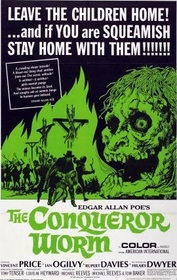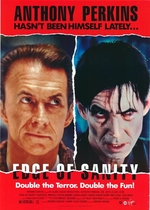Our editor-in-chief Nate Yapp is proud to have contributed to the new book Hidden Horror: A Celebration of 101 Underrated and Overlooked Fright Flicks, edited by Aaron Christensen. Another contributors include Anthony Timpone, B.J. Colangelo, Dave Alexander, Classic-Horror.com's own Robert C. Ring and John W. Bowen. Pick up a copy today from Amazon.com!
Witchfinder General (1968)
When “British”, “Horror” and “1960's” pop into most people’s heads, the next word is usually “Hammer”, but there were a few others plying their trade at that time. Companies such as London-based Tigon Films churned out a wide range of cheap and cheerful material from horror to soft-core porn to art house drama. Although most of Tigon's output has now sunk into obscurity, they did come up with one bona-fide classic – Witchfinder General. Despite a modest budget of less than £100,000, and a 24-year-old director with only two previous films to his name, it is a well-made, well-acted, very British work of surprising depth and uncompromising brutality, but with some unexpected links to a very American genre of film.
When "British", "Horror" and "1960's" pop into most people’s heads, the next word is usually "Hammer", but there were a few others plying their trade at that time. Companies such as London-based Tigon Films churned out a wide range of cheap and cheerful material from horror to soft-core porn to art house drama. Although most of Tigon's output has now sunk into obscurity, they did come up with one bona-fide classic – Witchfinder General. Despite a modest budget of less than £100,000, and a 24-year-old director with only two previous films to his name, it is a well-made, well-acted, very British work of surprising depth and uncompromising brutality, but with some unexpected links to a very American genre of film.
With England ravaged by the Civil War raging between pro and anti-royalists, the country has descended into anarchy and superstition. Vincent Price plays Matthew Hopkins, a lawyer very loosely based on an actual 17th century figure, who wanders from village to village, investigating allegations of witchcraft. However, his investigations consist of little more than getting his thuggish sidekick to torture suspects until they confess. When young soldier Richard Marshall (played by Ian Ogilvy) finds his fiancée Sara raped and her uncle murdered following a visit from Hopkins, he vows to hunt him down and take a violent revenge.
Although marketed as a horror film, Witchfinder General actually owes a major debt to the Western. Aside from the fact that the main characters ride around the countryside on horseback shooting guns at each other, the lurid cruelty (and highly unrealistic bright red blood) could have come right out of European efforts such as The Good, the Bad and the Ugly or Django. However, more interesting for me are the nods to the likes of Anthony Mann’s classic collaborations with James Stewart, such as The Naked Spur. From here, it borrows both the brooding, vengeance-driven feel, and characters who are, at times, morally ambiguous. Marshall and the Parliamentary forces may be the God-fearing "good guys" but even they are not adverse to stealing horses from farmers.
The opening two minutes set the tone for the whole film: a screaming woman is dragged along by a noisy jeering lynch mob, led by a priest. This is juxtaposed with shots of the peaceful English countryside, broken only by the hammering of a man building the gallows that will hang her. The contrast between the beauty and serenity of nature, and the ugliness and brutality of human beings and their actions is to me one of the most fascinating elements of the film. It crops us elsewhere, such as the post-credits scene where the tranquility of the forest is shattered by the slaying of a parliamentary soldier by a royalist sniper. It invites a very misanthropic reading of the film; director Michael Reeves seems to be saying that, when nature is left undisturbed, the planet runs nice and smoothly. It's only when humans arrive on the scene, with their petty games, crude superstitions and mob mentality, that things turn ugly and violent.
Having said all that, Witchfinder General is definitely first and foremost a horror film, just as much as The Texas Chain Saw Massacre and Henry: Portrait of a Serial Killer. Rather than ghosts, vampires or zombies, or even plants or animals turning against the human race, the real horror is the human race itself. In this world, religion is used to justify inflicting the most appalling violence on people. The priest may genuinely believe that this is for everyone's spiritual benefit, but for Hopkins the sadist it's merely an excuse. He's not alone in this point of view, with villagers using his services to settle scores with neighbors, providing him with baseless evidence and trumped up charges.
Reeves takes a novel of the same name as the basis for his screenplay (co-written with Tom Baker – no relation to the Doctor Who actor), but adds plenty of touches of his own. Between the seemingly endless war, the witch-hunts, and brutal realities of day-to-day survival, the villagers are shown to have become totally desensitized to the suffering of their fellow human beings. In one scene, a man looks on indifferently when he sees Sara being sexually assaulted. At one of Hopkins’ witch burnings, the crowd stand stone-faced, some of them looking almost bored, while people are lowered slowly into the flames, screaming in agony. A few minutes later children are shown roasting potatoes in the same flames, unaware or unbothered by the charred corpses nearby. As long as nobody stands up to him, or as long as people just accept it as part of life, Hopkins reign of terror can continue. The horror stems not just from what people do, but also what they do not do.
The decision to film entirely on location was a wise one. Reeves made the most of the same villages and buildings where 300 years earlier real life witch-hunts had taken place, which also saved him the trouble of constructing expensive sets from scratch. The daytime scenes are excellently shot with the countryside looking luscious and green, contrasting nicely with the grimness of the torture dungeons. Unfortunately, some of the scenes set in nighttime are rather obviously done in the day through a dark filter, an unfortunate byproduct of the very limited time and money available. However, given that the look of Witchfinder General for the most part belies the meager resources available, I think it would be churlish to complain too much about minor dips in quality.
According to both Price, and co-star and friend Ian Ogilvy, Reeves was not very good at communicating with actors. This reportedly led to a great deal of stress for the duration of the shoot. In his book, Nightmare Movies, Kim Newman tells how when Reeves made one particular suggestion, Price objected and snapped at the director: "I've made 87 films. What have you done?" Reeves responded: "two good ones."1 For my money, the tension was all worth it. By not letting Price fall back on his trademark hammy style and making him rely instead to use his natural charisma and on-screen presence, Reeves forced the actor to deliver a low-key performance of surprising intensity and depth. Price plays Hopkins as a sleazy opportunist, who will crush or double-cross anyone who stands in the way of him achieving his ends. Much as I love the likes of The Tingler or The Abominable Dr Phibes, I think it's a great shame we did not get a chance to see Price in more roles like this.
Price is always a tough act to follow, but Ian Ogilvy does an excellent job. More normally seen in lightweight TV shows such as Return of the Saint, Ogilvy turns in a memorable performance as the young soldier pushed over the edge by watching his dreams for a happy life with the woman he loves crumble before his eyes. He does not hold back either at the shocking, shattering climax. Shaking with rage, almost foaming at the mouth the anger that has building up is let loose in a bloody, frenzied, but cathartic attack on his tormentors.
Michael Reeves life and career also finished on a downbeat ending. After a finding his feet with a couple of no budget, hardly seen B-movie horror films, Witchfinder General showed he had a blossoming talent, and could fashion a work of depth, imagination and box office appeal from limited resources. But he never got the chance to show what he could have done with a more generous budget, dying aged just 25 from an accidental overdose of prescription medication. This happened shortly after the release of Witchfinder General, and his passing provided an unfortunate coda to this harrowing, unrelenting but brilliant work.
1. Newman, Kim. Nightmare movies: a critical history of the horror film, 1968-1988. [London]: Bloomsbury, 1989.
Trivia:
Michael Reeves originally wanted Donald Pleasence for the role of Matthew Hopkins, but he was overruled by American-International, who wanted to use Price so they could tie the film in with Roger Corman's defunct Poe cycle
The American release was titled The Conqueror Worm and opened with Price reading from the Edgar Allan Poe poem of the same name.
Witchfinder General was a big success for American-International; their £32,000 outlay netted them around $1.5 million in the States. The strong box office lead to a revival of the Poe cycle without Corman. However, The Oblong Box (1969), Cry of the Banshee (1970), and Murders in the Rue Morgue (1971) (all directed by Gordon Hessler) did not meet with anywhere near the same levels of box office return, putting the final nail in the coffin of this particular era of cinema.








